Nov 4, 2021 | Climate Change, Data and Methods, Risk and resilience
By Asjad Naqvi and Irene Monasterolo from the IIASA Advancing Systems Analysis Program
Asjad Naqvi and Irene Monasterolo discuss a framework they developed to assess how natural disasters cascade across socioeconomic systems.
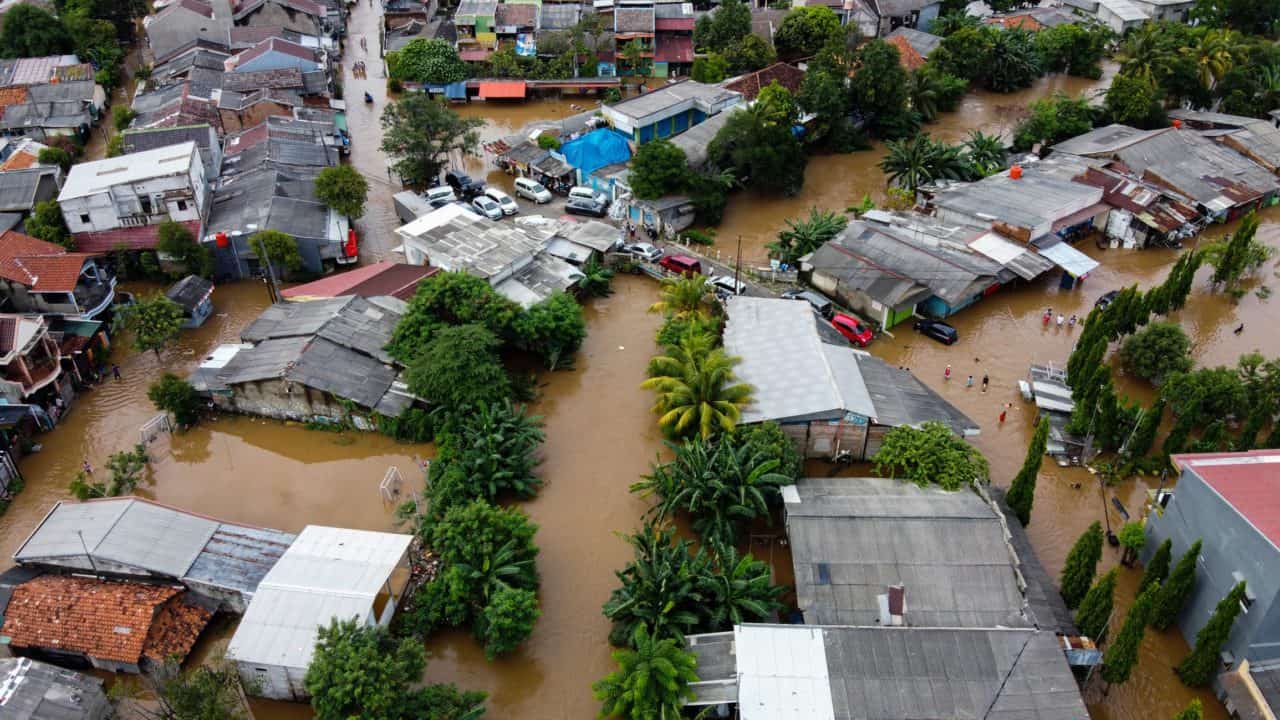
© Bang Oland | Dreamstime.com
The 2021 Nobel Prize for Physics, was awarded to the topic of “complex systems”, highlighting the need for a better understanding of non-linear interactions that take place within natural and socioeconomic systems. In our paper titled “Assessing the cascading impacts of natural disasters in a multi-layer behavioral network framework”, recently published in Nature Scientific Reports, we highlight one such application of complex systems.
In this paper, we develop a framework for assessing how natural disasters, for example, earthquakes and floods, cascade across socioeconomic systems. We propose that in order to understand post-shock outcomes, an economic structure can be broken down into multiple network layers. Multi-layer networks are a relatively new methodology, mostly stemming from applications in finance after the 2008 financial crisis, which starts with the premise that nodes, or locations in our case, interact with other nodes through various network layers. For example, in our study, we highlight the role of a supply-side production layer, where the flows are trade networks, and a demand-side household layer, which provides labor, and the flows are migration flows.
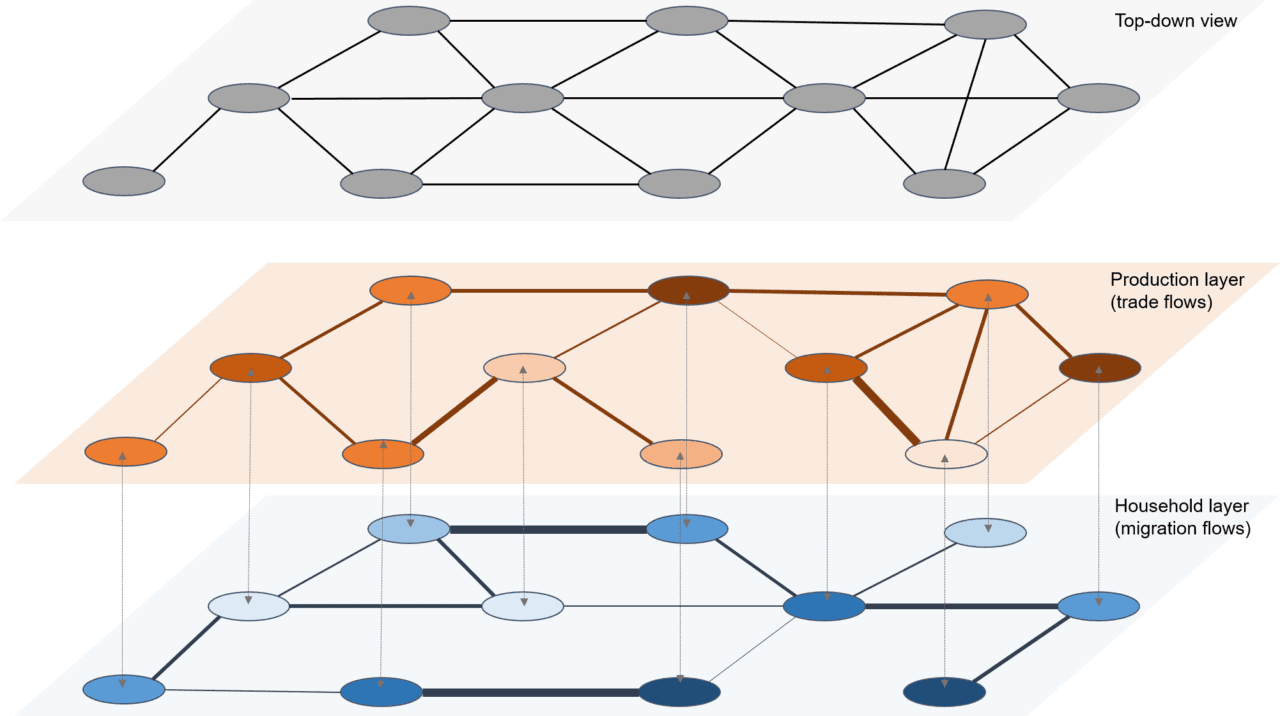
Figure 1: A multi-layer network structure
In this two-layer structure, the nodes interact, not only within, but across layers as well, forming a co-evolving demand and supply structure that feeds back across each other. The interactions are derived from economic literature, which also allow us to integrate behavioral responses to distress scenarios. This, for example, includes household coping mechanisms for consumption smoothing, and firms’ response to market signals by reshuffling supply chains. The price signals drive flows, which allows the whole system to stabilize.
We applied the framework to an agriculture-dependent economy, typically found in low-income disaster-prone regions. We simulated various flood-like shock scenarios that reduce food output in one part of the network. We then tracked how this shock spreads to the rest of the network over space and time.
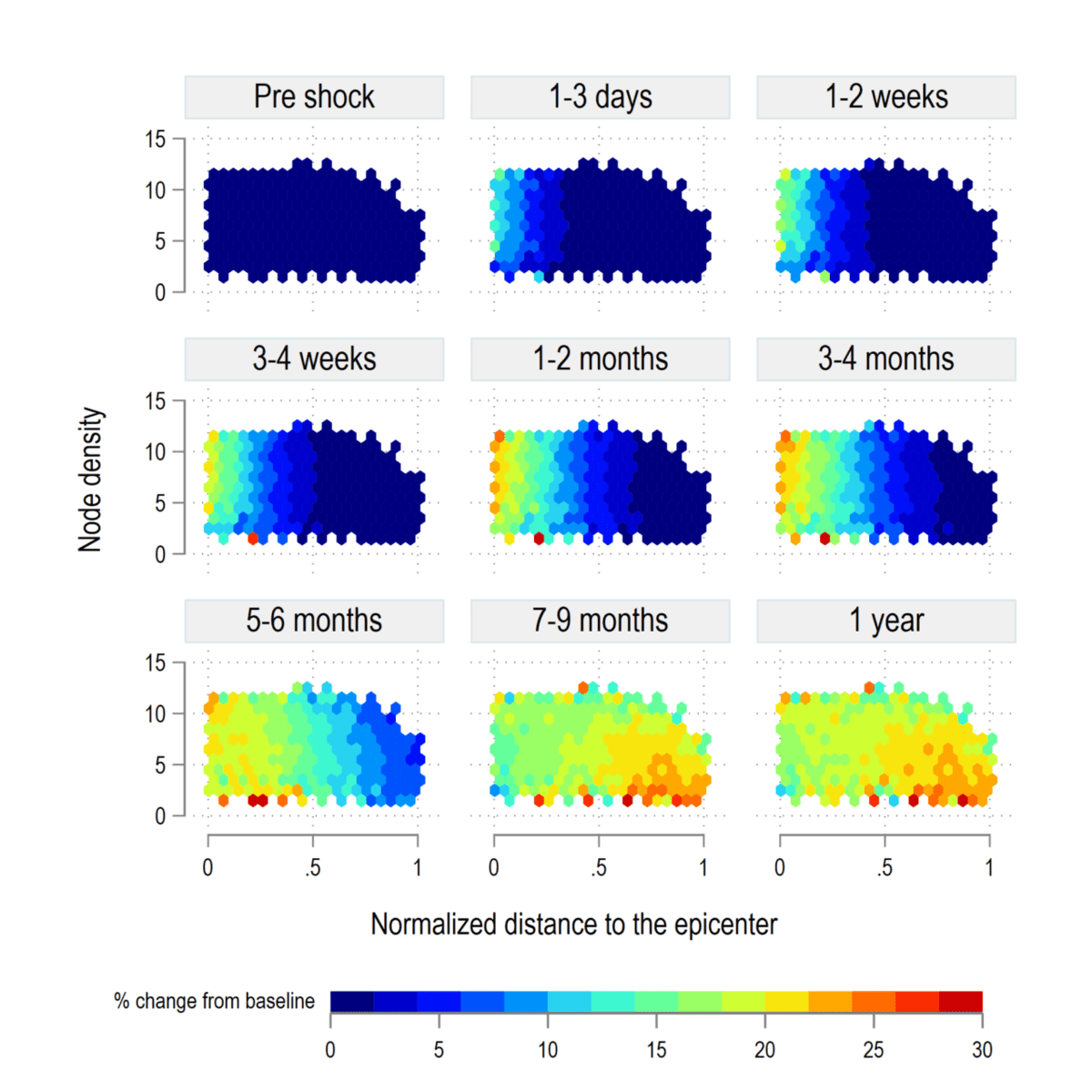
Figure 2: Evolution of vulnerability over time
Our results show that the transition phase is cyclical and depends on the network size, distance from the epi-center of the shock, and node density. Within this cyclical adjustment new vulnerabilities in terms of “food insecurity” can be created. Then, we introduce a new measure, the Vulnerability Rank, or VRank, to synthesize multi-layer risks into a single index.
Our framework can help inform and design policies, aimed at building resilience to disasters by accounting for direct and indirect cascading impacts. This is especially crucial for regions where the fiscal space is limited and timing of response is critical.
Reference:
Naqvi, A. & Monasterolo, I. (2021). Assessing the cascading impacts of natural disasters in a multi-layer behavioral network framework. Scientific Reports 11 e20146. [pure.iiasa.ac.at/17496]
Note: This article gives the views of the author, and not the position of the Nexus blog, nor of the International Institute for Applied Systems Analysis.
Jul 19, 2021 | IIASA Network, Risk and resilience, Women in Science
By Raquel Guimaraes, guest research scholar in the IIASA Migration and Sustainable Development and Equity and Justice research groups and assistant professor at the Federal University of Parana in Brazil
IIASA Network and Alumni Officer, Monika Bauer, recently invited me to participate in a genuinely important event hosted on IIASA Connect with the aim of gathering the IIASA community to discuss the gender dimension in research. As a gender researcher, this topic is part of my daily activities, and I decided to focus on the most important findings of my research: gender, disasters, and climate change.

© Raquel Guimaraes
In my talk, I gave an overview of the data relating to gender and disasters. According to the United Nations Development Programme, disasters lower women’s life expectancy more than men’s; moreover, women and children are 14 times more likely to die during a disaster. For example, most of the victims trapped in New Orleans after Hurricane Katrina were African-American women and their children.
Given these facts, it becomes clear that gender is an important dimension of disaster and climate change research. Why is that? First, because gender and natural disasters are socially constructed under different geographic, cultural, political-economic, and social conditions and it has complex social consequences for both women and men. They therefore highlight societal, cultural, and religious norms and values, and shape the needs and risks of the affected individuals. Second, because disasters often affect women, girls, men, and boys differently due to gender inequalities caused not only by socioeconomic conditions, but also by cultural beliefs and traditional practices.
In addition to the above, climate change is connected to an increase in the frequency and/or severity of natural disasters such as flooding, heat waves, and cyclones. Disasters will therefore exacerbate existing inequalities and vulnerabilities in communities, since, as already mentioned, they have a wide range of effects for men and women, as well as for youth and children in both developing and developed countries.
Interestingly, the discussion on the intersection between gender and disasters is not new. References to gender as an issue in climate change debates and international protocols on disaster management have been made since at least the 1994 Yokohama World Conference on Natural Disaster Reduction. Since then, the international community has repeatedly called for gender-responsive disaster risk management.
To ensure gender equality and to overcome problems of marginalization, invisibility, and under-representation, gender concerns and women’s issues has been included into mainstream disaster risk reduction policies. Hence, understanding different gender roles, responsibilities, needs, and capacities to identify, reduce, prepare, and respond to disasters, is crucial to promoting effective disaster risk management.
Given the gender dimension of climate change and disaster research, some important questions that come to mind are: Do women really lack power in disasters? Are they really the fragile gender? The answer is: not always. Evidence shows that, despite gender-differentiated vulnerabilities, women and girls are also powerful agents of positive change before, during, and after disasters.
My research on floods, for instance, shows that in Brazil and Thailand, women can be agents of change. Preparedness to natural disasters have been recognized as key in disaster risk management to the extent that local and international actors emphasize the importance of saving lives and avoiding losses, even before the onset of a disaster. If there are different strategies for disaster prevention according to gender, then emergency management agencies and policymakers should account for these differences, ensuring that men and women combine their strengths to maximize preparedness for floods. Through data from two surveys, I evaluated preparedness by assessing several indicators that accounts for the provision of protective items, emergency plans, and the availability of insurance or information. Using econometric models, I found that women play an active role in disasters, being resourceful actresses in times of crises.
Therefore, during the IIASA Connect Coffee Talk I asserted that gender should be integrated as the basis of a complex and dynamic set of social relations in disaster and climate change research. I appreciate the opportunity IIASA Connect gave me to reflect on this issue with colleagues.

Note: This article gives the views of the author, and not the position of the Nexus blog, nor of the International Institute for Applied Systems Analysis.
May 20, 2021 | COVID19, Poverty & Equity, Risk and resilience, Women in Science
By Benigna Boza-Kiss, Shonali Pachauri, and Caroline Zimm from the IIASA Transformative Institutional and Social Solutions Research Group
Benigna Boza-Kiss, Shonali Pachauri, and Caroline Zimm explain how COVID-19 has impacted the poor in cities and what can be done to increase the future resilience of vulnerable populations.
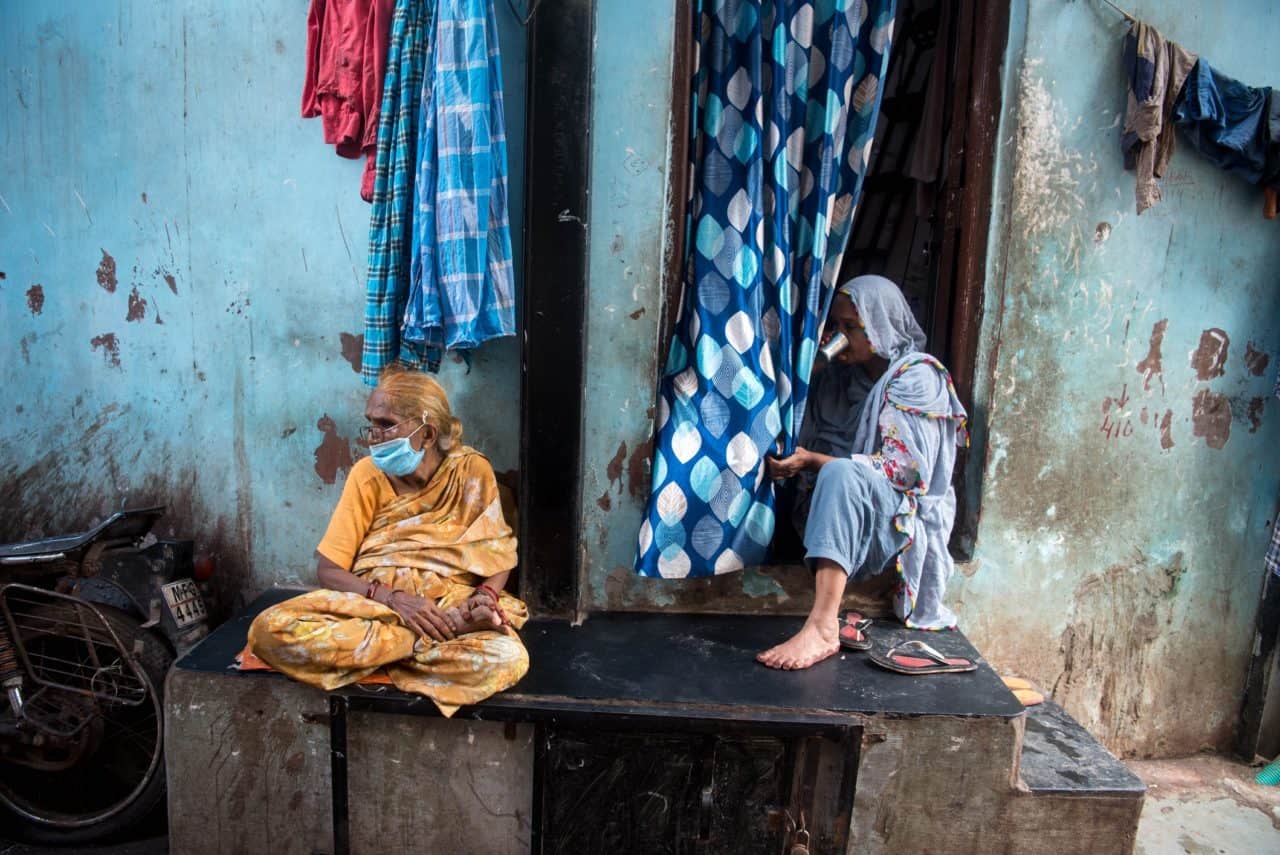
© Manoej Paateel | Dreamstime.com
The COVID-19 pandemic has brought a halt to life as we knew it. We have been restrained in our activities and freedoms, forced to stay indoors at home, to cancel travel plans, and to transfer meetings to an online space, where most of us have also celebrated birthdays and other important life events that should have been in person with our loved ones. These changes have impacted many aspects of our comfort, our social wellbeing, as well as our financial situations, but it has also brought existing inequalities and poverty into the spotlight.
The risks of the pandemic and restrictions following containment measures have been felt most acutely by the poor, the vulnerable, those in the informal sector, and those without savings and safety nets. The suffering of women in the health sector, school children in households without electricity and internet, workers in the informal sector that don’t have the option to telework, crowds living in slums – to name just a few examples of vulnerable groups – have become glaringly visible to all. These people have had to adapt to new rules and conditions when they were living on the edge even before the pandemic.
In a new perspective piece published in the journal Frontiers in Sustainable Cities, we explored how aspects related to access to shelter/housing, modern energy, and digital services in cities have influenced the poor and what can be done to increase the future resilience of vulnerable populations.
We described three ways in which the COVID-19 pandemic and related containment measures have exacerbated urban inequalities, and identified how subsequent recovery measures and policy responses could redress these.
First, lockdowns amplified urban energy poverty. Staying at home has meant increased energy use at home. For the poor, who already struggle with utility costs, and typically live in low energy quality buildings, these services have become even more unaffordable. These populations also shoulder a higher burden of poor health, for example, higher incidence of respiratory problems, with poor or inadequate ventilation and insulation increasing their risk of infection even more.
Second, preexisting digital divides have surfaced, even within well-connected cities. Multiple barriers limit digital inclusion: access to digital technologies due to high costs (for devices, internet access, and electricity connections), and unreliable services (again both for electricity and internet), as well as low digital literacy and support. This lack of adequate digital service access is contributing to these populations falling further behind during lockdowns as they miss out on education and income.
Third, slum dwellers in the world’s cities have been particularly hard hit, because of precarious and overcrowded housing conditions, lack of basic infrastructure and amenities, and a high concentration of the socioeconomically disadvantaged, resulting in even more negative consequences of lockdown measures. With many slum inhabitants working in the informal sector, many have been left either without jobs and income, or have been compelled to work in precarious and unsafe conditions to survive. The loss of income has also had knock-on effects, making payments of regular expenditures for rent, water, electricity, and other utility services difficult. Women within these settlements have been disproportionately impacted by the pandemic, as they are over represented in the informal economy, and more likely to be engaged in invisible work, such as home-based or domestic and care work.
Recovery measures need to ensure immediate relief, but also point towards long-term solutions that contribute to the redistribution of wealth and new urban development, while also increasing resilience to the current and future pandemics or other disasters. There are tested measures that should be reemphasized.
Urban green recovery plans that include large-scale home renovation programs could ensure warm, healthy homes, and affordable energy bills for all. In the shorter-term, alleviation of payment defaults on the rents and utility bills of the energy poor should continue. In parallel, urban digital preparedness, more equal access to the virtual delivery of essential services, and provision of opportunities for virtual working and education for all in the future, need attention.
COVID-19 can be a wake up call to increase efforts to close the digital divide and push for structural change. The crisis has increased the urgency to redesign and improve informal settlements and provide adequate and efficient services that address the diverse needs of poor urban residents. This requires partnerships between urban municipalities, planners, and stakeholders, as well as strengthening local communities for inclusive planning strategies. More immediately, it is necessary to provide direct support to slum and informal settlement populations in terms of income support, adequate nutrition, energy, water, and other basic infrastructure and services.
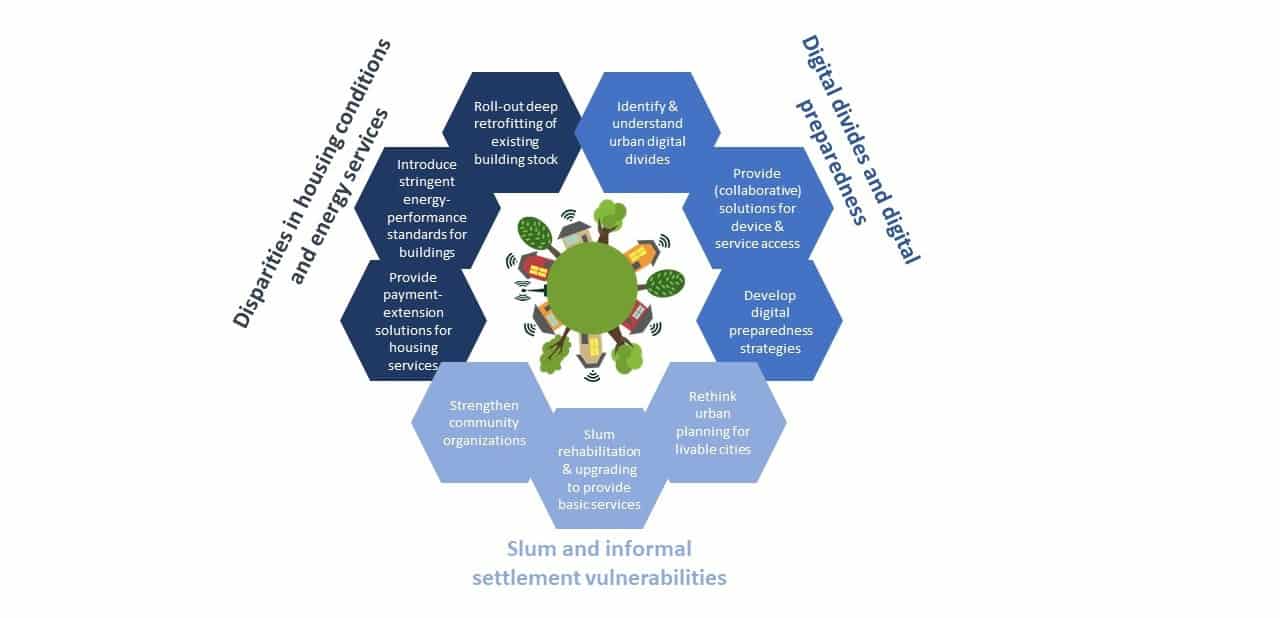 All in all, the COVID-19 pandemic has been a “test of societies, of governments, of communities, and of individuals”. Digital technologies, home renovation, and slum rehabilitation are the means, rather than the end to improve conditions for all, but if specifically targeted to the poor and most deprived, such measures can reduce inequalities and increase resilience.
All in all, the COVID-19 pandemic has been a “test of societies, of governments, of communities, and of individuals”. Digital technologies, home renovation, and slum rehabilitation are the means, rather than the end to improve conditions for all, but if specifically targeted to the poor and most deprived, such measures can reduce inequalities and increase resilience.
Reference:
Boza-Kiss, B., Pachauri, S., & Zimm, C. (2021). Deprivations and Inequities in Cities Viewed Through a Pandemic Lens. Frontiers in Sustainable Cities 3 e645914. [pure.iiasa.ac.at/17121]
Note: This article gives the views of the author, and not the position of the Nexus blog, nor of the International Institute for Applied Systems Analysis.
May 12, 2021 | Poverty & Equity, Risk and resilience, Sustainable Development
by Viktor Roezer | Swenja Surminski | Finn Laurien | Colin McQuistan | Reinhard Mechler | Anna Svensson
Disaster Risk Reduction investments bring a wide variety of benefits, including economic, ecological, and social, but in practice these multiple resilience dividends are often not included in investment appraisals or are not recognized by those making funding decisions. How do we change this?
Research led by the London School of Economics and Political Science with IIASA and Practical Action published in the Working Paper Multiple resilience dividends at the community level: A comparative study on disaster risk reduction interventions in different countries highlights the need for an integrated decision-making framework to overcome the challenges.
The negative effects of disasters on people and communities are varied and far reaching, and will only get worse as climate change make floods and other natural hazards more frequent, severe, and unpredictable. Disasters lead to loss of lives, assets, and livelihoods, they undermine or destroy development progress. Since 2000 climate related hazards have caused $2.2 trillion of losses and damages and have affected approximately 3.9 billion people globally.
With investments in disaster risk reduction (DRR), where community resilience is enhanced these negative impacts can be reduced and savings can be made. It’s more cost effective to invest in pre-event resilience than post-event response and recovery.
So why is disaster risk reduction so difficult to finance?
The problem with estimating the direct benefit of disaster risk reduction interventions is that you only see the benefits when an event which would otherwise have turned into a disaster occurs and is successfully mitigated.
This makes cost-benefit analysis and other decision-making methods difficult to carry out, and makes the costs of doing something more aligned to the probability of the event, rather than the lives and economic costs saved, thus changes to policy and practice are slow to materialize.
What are the multiple dividends of resilience?
The multiple dividends of resilience refer to positive socioeconomic outcomes generated by, and co-benefits of, an intervention beyond, and in addition to, risk reduction.
It’s an approach aimed at making DRR investments more attractive as the multiple dividends of an investment may help identify win-win-win situations (as well as trade-offs), even if no hazard event occurs. Co-benefits can be intended, or unintended.
As framed by the Triple Resilience Dividend concept these benefits can be divided into three categories:
1. The avoided losses and damages in case of a disaster
For example, how bio-dykes in Nepal prevent river bank erosion, which reduces the risk of flooding, and associated sand deposits that ruin the fertility of agricultural land.
2. The economic potential of a community that is unlocked through the intervention
This includes ecosystem-based adaptation solutions in Vietnam where mangrove plantations create new habitats for fish, leading to improved livelihood opportunities for those making their living from fishing.
3. Other development co-benefits
Transition to solar stoves in rural Afghanistan does not only protect natural capitals from degradation, but also empowers women and girls, reduces in-house smog pollution, and fosters technological innovations.

Rongali next to his community’s bio-dyke. Photo by Sanjib Chaudhary, Practical Action.
What are the challenges?
The triple resilience dividend approach is often linked to new and innovative solutions like ecosystem based adaptation, where the benefits can be wider, but when and how they will materialize is more uncertain than with traditional, hard infrastructure solutions.
Although many developing countries have policies that align DRR, climate change adaptation, and sustainable development, sadly, in practice, local decision makers assume that multiple resilience dividends will only accumulate over the long term. This often leads them to select traditional, hard infrastructure solutions that offer quick and more visible protection.
We need more success stories. Pilot interventions can be shared and shown to community members and decision makers to overcome their skepticism but this require better and more comprehensive evidence than we have today.
We also lack decision-making frameworks that can include and monitor multiple resilience dividends. Frameworks that support planners as they navigate the decision-making process, and help generate the evidence needed.

Community members in the Peruvian Andes working at a local tree nursery. Photo by Giorgio Madueño , Practical Action
How do we overcome these challenges?
The solution suggested in Multiple resilience dividends at the community level: A comparative study on disaster risk reduction interventions in different countries is an integrated decision-making framework that allows to systematically include, appraise, implement, and evaluate individual resilience dividends at each stage of the decision-making process.
Application and relevance matters.
As we suggest, instead of maximizing resilience dividends based on a specific, one dimensional, metric (e.g., monetary benefits) decision-making approaches need to identify those dividends that are most needed and demanded by the community and the solutions, novel or local in nature, best suited to generate these.
A structured approach in combination with participatory decision making allows for a tailored approach where community buy-in is achieved by prioritizing the resilience dividend(s) that matter most to them, while at the same time contributing to the evidence base for multiple resilience dividends.
This is urgently needed to highlight the fundamental challenges with the existing planning and decision-making system and therefore generate demand to deliver more effective solutions at scale.
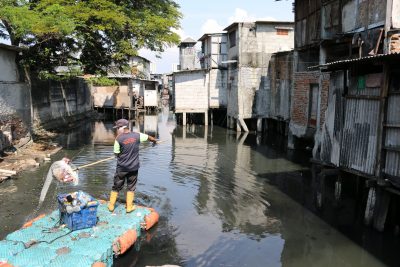
Cleaning waste from river in Penjaringan Urban Village, Jakarta, Indonesia. Photo by Piva Bell, Mercy Corps.
Read the working paper this blog is based on here.
This blog post first appeared on the Flood Resilience Portal. Read the original post here.
Note: This article gives the views of the author, and not the position of the Nexus blog, nor of the International Institute for Applied Systems Analysis.
May 5, 2021 | Climate Change, Poverty & Equity, Risk and resilience
By Julian Joseph, research assistant in the Water Security Research Group
Julian Joseph explains the concept of the triple dividend of disaster risk reduction investments based on the application of a novel economic model applied to a case study undertaken in Tanzania and Zambia.
What are the benefits of Disaster Risk Reduction (DRR) investments such as dams and the introduction of drought-resistant crops in agriculture for an economy? They are threefold and called the “triple dividend” of DRR investments. The first dividend comprises the direct effects of DRR investments, which limit damage to houses, infrastructure, and other physical assets and prevent death and injury. The second dividend unlocks the economic potential of an economy because risk reduction drives people and businesses to invest more, as they expect less of what they invest in to be destroyed by disasters, while the third dividend is comprised of development co-benefits through other uses the investments provide.
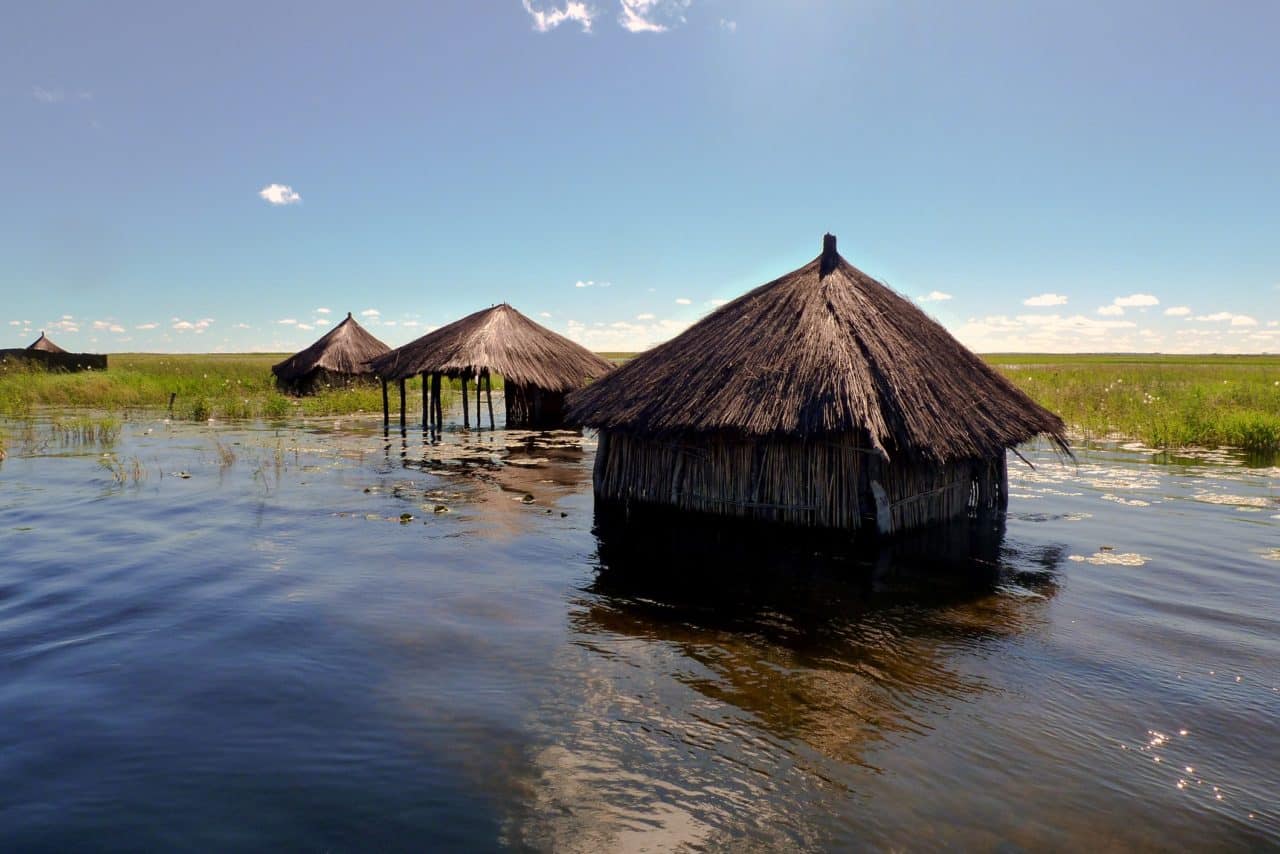
© Gerrit Rautenbach | Dreamstime.com
Using a new macroeconomic model called DYNAMMICs, my colleagues and I have found that there is often a significant growth effect for the economy attached to investing in mitigation measures like dams and drought resistant crops, which is commonly underestimated in traditional models. One reason for this is the focus of other models on only the first, direct dividend. We specifically looked into the examples of Tanzania and Zambia, which show that governments and other stakeholders in developing countries can spur economic growth by investing in DRR measures, thus increasing future earnings and creating a safe environment for investments into other economic activities.
In Tanzania and Zambia, floods affect tens of thousands of people each year (on average 45,000 or .08% of the population in Tanzania and 20,000 or .11% of the population in Zambia). Droughts have more widespread consequences and already affect 11.8% of the population in Tanzania and 19% of Zambians who often lose all or parts of their harvest. This poses an imminent threat to food security in countries where substantial shares of the population rely on subsistence farming as their primary source of income. Given the effects of climate change, these numbers and their ramifications are bound to become ever more pressing issues. However, policymakers, institutions, enterprises, and individuals tend to underinvest in adaption measures.
A promising avenue for demonstrating the potential of DRR investments is offered by including all economic growth effects they invoke into policy analysis, thus showing that besides risk reduction and post-disaster mitigation of destruction, investing in DRR measures can help countries achieve many of their other development goals as well.
We tend to only think of the first dividend of DRR investments, the direct effects of which stop people from being immediately affected by disasters. In the case of Tanzania and Zambia, we examined, among others, the benefits of constructing additional dams. The direct benefits of dams lie in the safeguarding of livelihoods, infrastructure, housing, and agricultural production. These are seen as the first dividend, called the ex-post damage mitigation effect. There are however also additional co-benefits.
In both Tanzania and Zambia, large shares of the population are heavily dependent on agriculture, which makes the introduction of drought-resistant crop varieties such an additional benefit. These crop varieties do not only help farmers preserve their yields in times of disastrous droughts, but additionally support farmers by generating higher yields, even in the absence of disaster. This effect is boosted by the lowered risk for the loss of crops, which spurs investment into farming activities and inputs. Farmers who do not fear losing their entire harvest can, and generally will, invest more into the production of this crop – an example of the second type of dividend, the ex-ante risk reduction effect. This type of economically beneficial effect materializes regardless of the onset of disaster.
The same is true for the third type of dividend, the co-benefit production expansion effect, which is especially relevant for the advantages of dams. The power generation capability of dams, leads to much larger economic gains than the two other dividends combined. In countries such as those at hand with frequent power cuts and comparably low levels of electrification, especially in rural areas, the additional electricity generated can lead to particularly pronounced positive effects by supplying economic actors with access to power. In other scenarios, the provision of ecosystem services is also an important effect falling into this category.
The results we obtained using the DYNAMMICs model are promising: Constructing only two additional dams leads to a 0.3% increase of GDP growth in Tanzania for the next 30 years (0.2% in Zambia) with results largely (97%) driven by the co-benefit production expansion effect. Similarly, the introduction of drought resistant crops and exposure management (i.e., land use restrictions) significantly boost economic growth perspectives. Finally, introducing insurance is a driver for a reduction in the variance of GDP growth, which helps to reduce uncertainty for everyone in the economy. Modeling in such a fashion is therefore an important means of weighing policy options for DRR against each other and for determining optimal levels of investment.
Note: This article gives the views of the author, and not the position of the Nexus blog, nor of the International Institute for Applied Systems Analysis.
Feb 2, 2021 | Environment, Poverty & Equity, Risk and resilience, Young Scientists
By Prakash Khadka, IIASA Guest Research Assistant and Wei Liu, Guest Research Scholar in the IIASA Equity and Justice Research Group
Prakash Khadka and Wei Liu explain how unbridled, unplanned infrastructure expansion in Nepal is increasing the risk of landslides.
Worldwide, mountains cover a quarter of total land area and are home to 12% of the world’s population, most of whom live in developing countries. Overpopulation and the unsustainable use of these fragile landscapes often result in a vicious cycle of natural disaster and poverty. Protecting, restoring, and sustainably using mountain landscapes is an important component of Sustainable Development Goal 15 ̶ Life on Land ̶ and the key is to strike a balance between development and disaster risk management.
Nepal is among the world’s most mountainous countries and faces the daunting challenge of landslides and flood risk. Landslide events and fatalities have been increasing dramatically in the country due to a complex combination of earthquakes, climate change, and land use, especially the construction of informal roads that destabilize slopes during the monsoon.
According to Nepal government data, 476 incidents of landslides and 293 fatalities were recorded during the 2020 monsoon season – the highest number in the last ten years, mostly triggered by high-intensity rainfall – a trend which is increasing due to climate variations. According to one study, by mid-July 2020, the number of fatal landslides for the year had already exceeded the average annual total for 2004–2019.
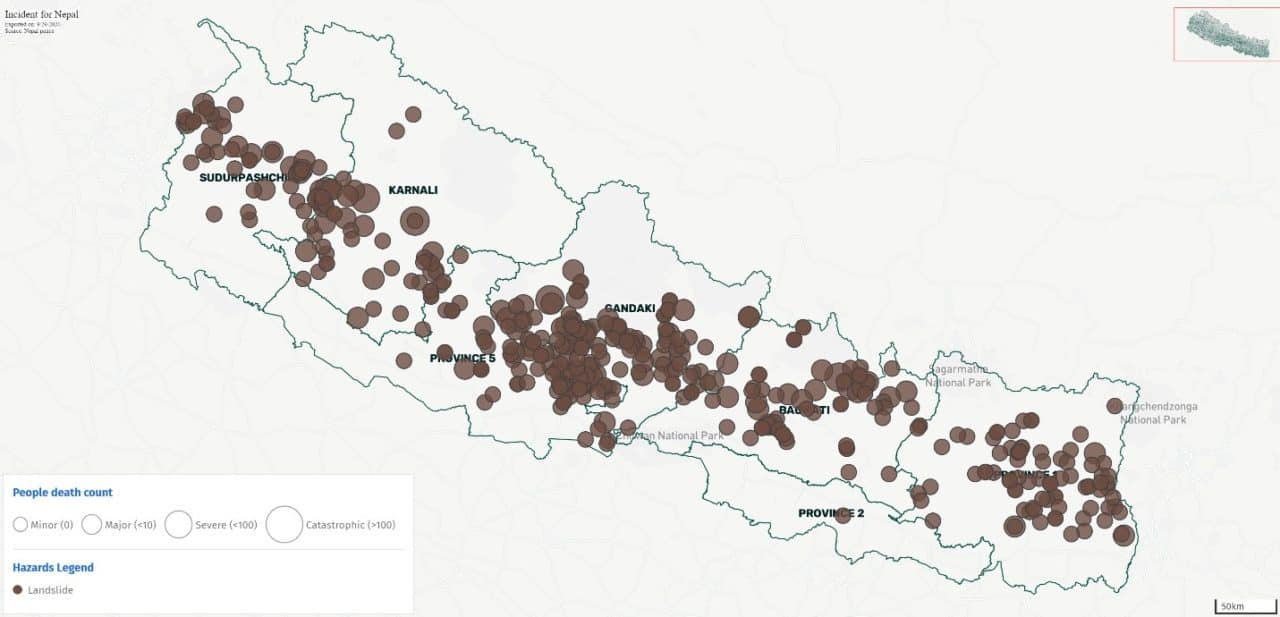
Figure 1: A map of landslide events in Nepal from June to September 2020. Source: bipadportal.gov.np
Landslides are not a new phenomenon in the country where hills and mountains cover nearly 83% of the total land area. While being destructive, landslides are complex natural processes of land development. The Gangetic plain, situated in the foothills of the Himalayas, was formed by the great Himalayan river system to which soil is continually added by landslides and deposited at the base by rivers. Mountain land changes via natural geo-tectonic and ecological processes has been happening for millions of years, but fast population growth and climate change in recent decades substantially altered the fate of these mountain landscapes. Road expansion, often in the name of development, plays a key role.
Many mountain areas in Nepal are physically and economically marginalized and efforts to improve access are common. Poverty, food insecurity, and social inequity are severe, and many rural laborers opt to migrate for better economic opportunities. This motivates road network expansion. Since the turn of the century, Nepalese road networks has almost quadrupled to the current level of ~50 km per 100 km2, among which rural roads (fair-weather roads) increased more than blacktop and gravel roads.
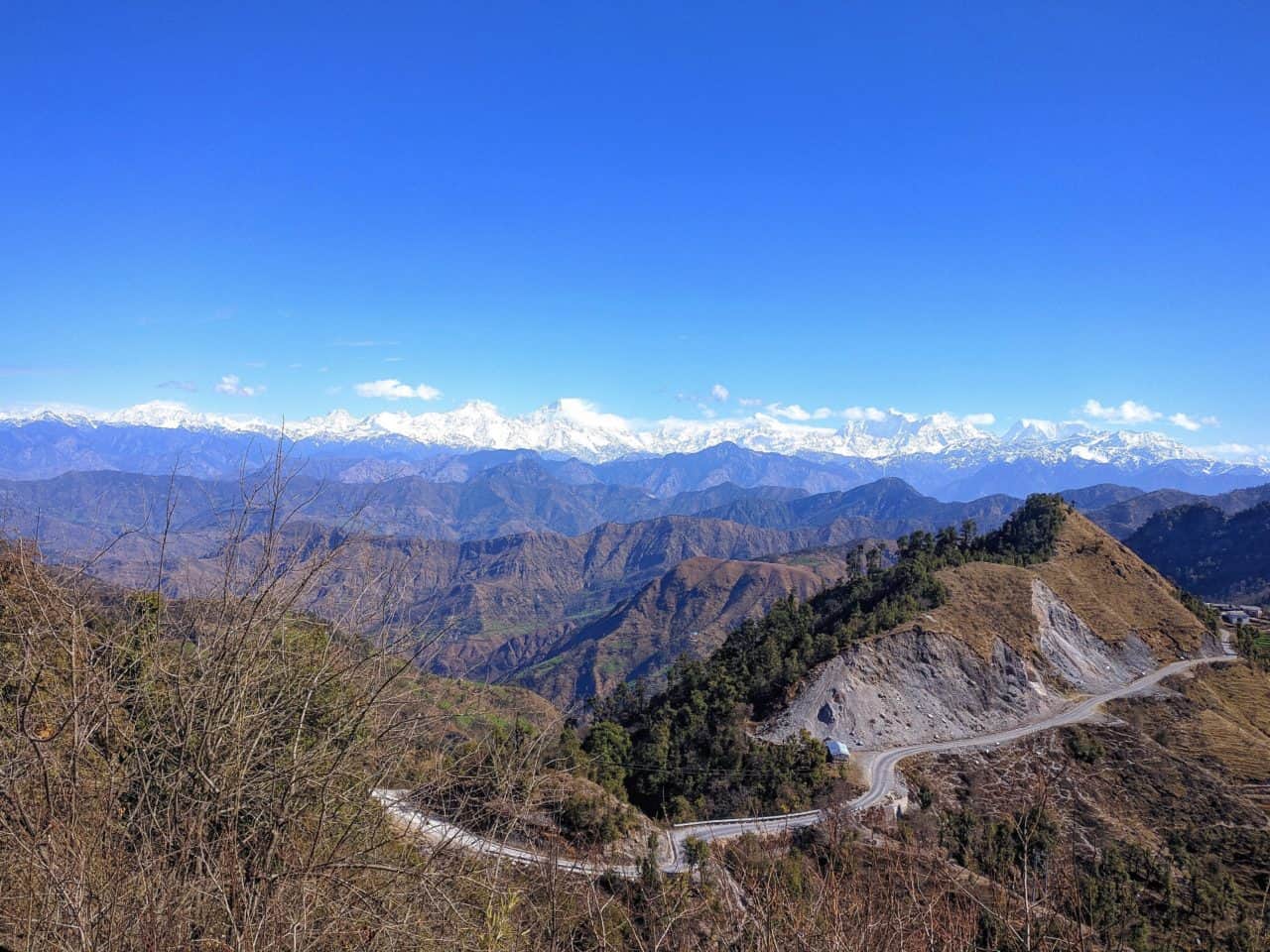
Figure 2: Mountains carved just above Jay Prithvi Highway in Bajhang district of Sudurpaschim province to build a road
Nepalese mountain roads are treacherous and subject to accidents and landslides. Rural roads, which are often called “dozer roads”, are constructed by bulldozer owners in collaboration with politicians at the request of communities (also as part of the election manifesto in which politicians promised road access in exchange for votes and support to win), often without proper technical guidance, surveying, drainage, or structural protection measures. In addition, mountains are sometimes damaged by heavy earthmovers (so-called “bulldozer terrorism”) that cut out roads that lead from nowhere to nowhere, or where no roads are needed, at the expense of economic and environmental degradation. Such rapid and ineffective road expansion happens throughout the country, particularly in the middle hills where roads are known to be the major manmade driver of landslides.
To tackle these complexities, we need to rethink how we approach development in light of climate change. This has to be done with sufficient investigation into our past actions. The Nepalese Community forestry management program, which emerged as one of the big success stories in the world, encompasses well defined policies, institutions, and practices. The program is hailed as a sustainable development success with almost one-third of the country’s forests (1.6 million hectares) currently managed by community forest user groups representing over a third of the country’s households. Another successful example is the innovation of ropeways and its introduction in the Bhattedanda region South of Kathmandu. The ropeways were instrumental in transforming farmers’ lives and livelihoods by connecting them with markets. Locals quickly mastered the operation and management of the ropeway technology, which was a lifesaver following the 2002 rainfall that washed away the road that had made the ropeway redundant until then.
These two examples show that it is possible to generate ecological livelihoods for several households in Nepal without adversely affecting land use and land cover, which in turn contributes to increased landslide risk in the country, as mentioned above.
A rugged landscape is the greatest hindrance to the remote communities in a mountainous country like Nepal. It cannot be denied that the country needs roads that serve as the main arteries for development, while local innovations like ropeways can well complement the roads with great benefits, by linking remote mountain villages to the markets to foster economic activities and reduce poverty. Such a hybrid transportation model is more sustainable economically as well as environmentally.
It is a pity that despite strong evidence of the cost-effectiveness of alternative local solutions, Nepal’s development is still mainly driven by “dozer constructed roads”. Mountain lives and livelihoods will remain at risk of landslides until development tools become more diverse and compatible.
References:
- Gyawali, D. (Ed.), Thompson, M. (Ed.), Verweij, M. (Ed.). (2017). Aid, Technology and Development. London: Routledge, https://doi.org/10.4324/9781315621630
- Gyawali, Dipak; Dixit, Ajaya; Upadhya, Madhukar (2004). Ropeways in Nepal.
- Petley, D. N. (2020). The deadly start to the monsoon season in Nepal – The Landslide Blog – AGU Blogosphere. The Landslide Blog. https://blogs.agu.org/landslideblog/2020/07/24/nepal-2020/
Note: This article gives the views of the author, and not the position of the Nexus blog, nor of the International Institute for Applied Systems Analysis.








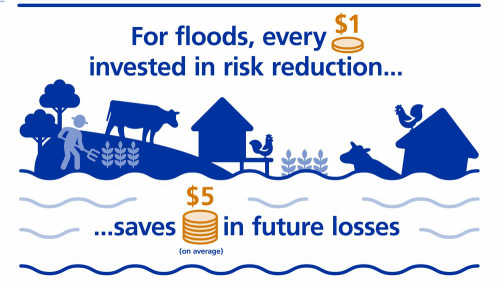






You must be logged in to post a comment.